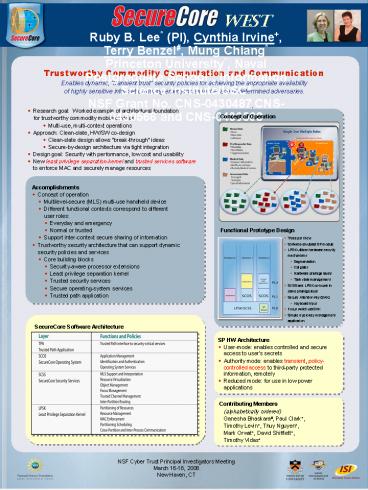SecureCore Poster Jan 07 PowerPoint PPT Presentation
1 / 1
Title: SecureCore Poster Jan 07
1
WEST
Ruby B. Lee (PI), Cynthia Irvine, Terry
Benzel, Mung Chiang Princeton University,
Naval Postgraduate School, Information Science
Institute/USC NSF Grant No. CNS-0430487,
CNS-0430566 and CNS-0430598
Trustworthy Commodity Computation and
Communication Enables dynamic, "transient trust"
security policies for achieving the appropriate
availability of highly sensitive information
during emergencies in the face of determined
adversaries.
- Research goal Worked example of architectural
foundation - for trustworthy commodity mobile devices
- Multi-use, multi-context operations
- Approach Clean-slate, HW/SW co-design
- Clean-slate design allows break-through ideas
- Secure-by-design architecture via tight
integration - Design goal Security with performance, low cost
and usability - New least privilege separation-kernel and trusted
services software to enforce MAC and securely
manage resources
Concept of Operation
- Accomplishments
- Concept of operation
- Multilevel-secure (MLS) multi-use handheld
device - Different functional contexts correspond to
different - user roles
- Everyday and emergency
- Normal or trusted
- Support inter-context secure sharing of
information - Trustworthy security architecture that can
support dynamic - security policies and services
- Core building blocks
- Security-aware processor extensions
- Least privilege separation kernel
- Trusted security services
- Secure operating-system services
- Trusted path application
- Functional Prototype Design
- Three partitions
- Software-emulated SP module
- LPSK utilizes hardware security mechanisms
- Segmentation
- Cal gates
- Hardware privilege levels
- Task state management
- SCSS and LPSK co-locate in
- same privilege level
- Secure Attention Key (SAK)
- Keyboard input
- Focus switch via SAK
- Simple crypto key management application
SecureCore Software Architecture
- SP HW Architecture
- User-mode enables controlled and secure access
to user's secrets - Authority mode enables transient,
policy-controlled access to third-party protected
information, remotely - Reduced mode for use in low power applications
Contributing Members (alphabetically ordered)
Ganesha Bhaskara, Paul Clark, Timothy
Levin, Thuy Nguyen, Mark Orwat, David
Shifflett, Timothy Vidas
NSF Cyber Trust Principal Investigators
Meeting March 16-18, 2008 New Haven, CT

